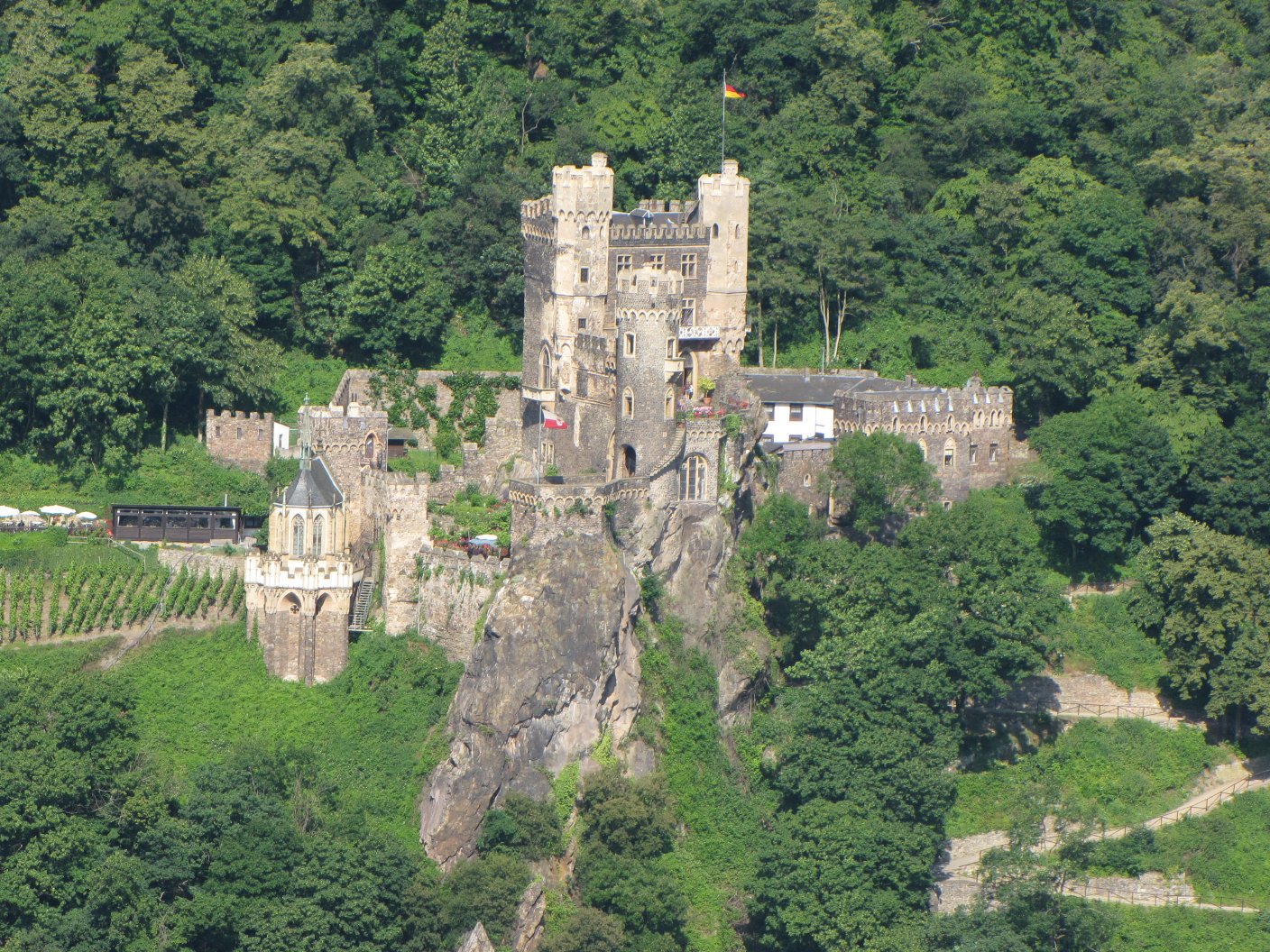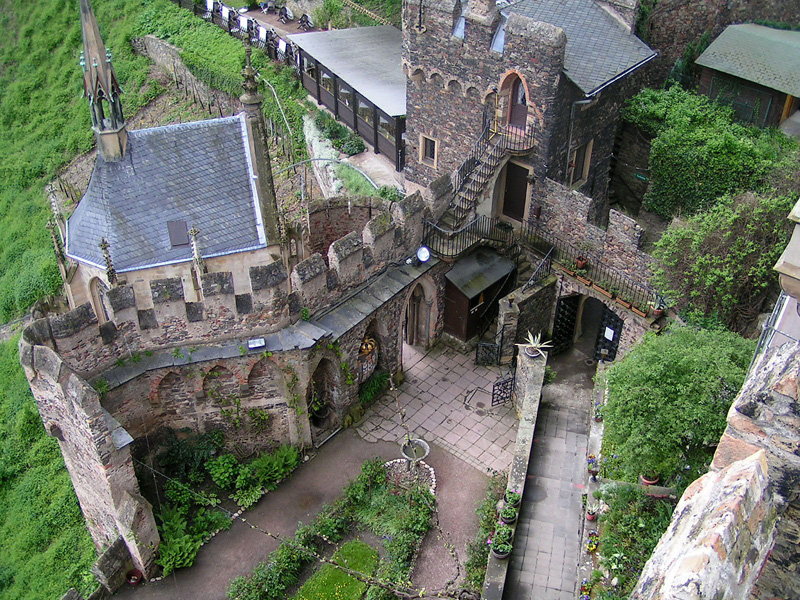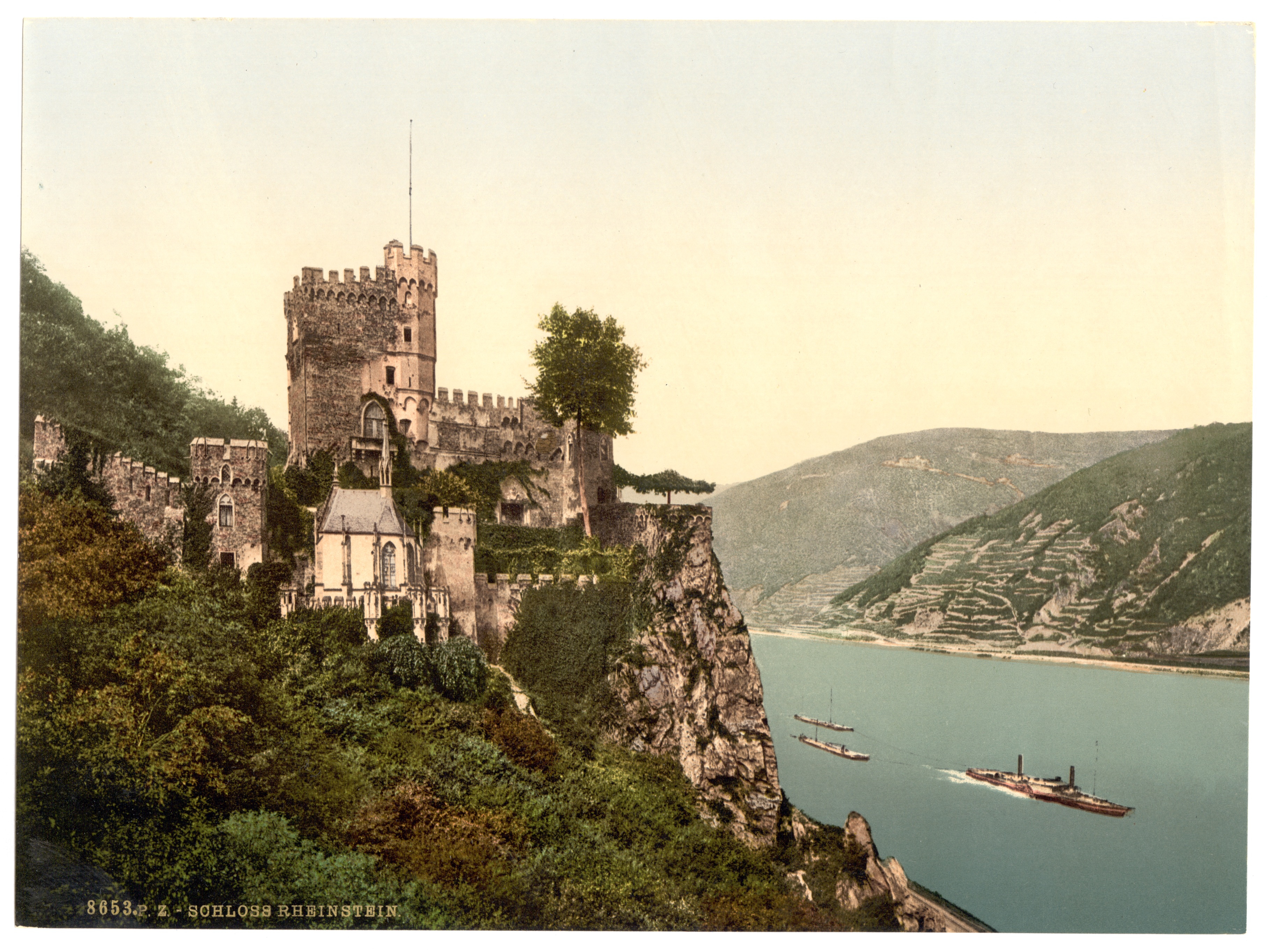Burg Rheinstein on:
[Wikipedia]
[Google]
[Amazon]


 Rheinstein Castle (german: Burg Rheinstein) is a
Rheinstein Castle (german: Burg Rheinstein) is a
http://www.burg-rheinstein.de
* :de:Burg Rheinstein
Aerial views of Rheinstein CastleInterview with Markus Hecher, the owner of Rheinstein Castle
{{Castles in Germany - The Middle Rhine Valley Rheinstein Museums in Rhineland-Palatinate Historic house museums in Germany


 Rheinstein Castle (german: Burg Rheinstein) is a
Rheinstein Castle (german: Burg Rheinstein) is a castle
A castle is a type of fortified structure built during the Middle Ages predominantly by the nobility or royalty and by military orders. Scholars debate the scope of the word ''castle'', but usually consider it to be the private fortified r ...
near the town of Trechtingshausen
Trechtingshausen (formerly also ''Trechtlingshausen'') is an ''Ortsgemeinde'' – a municipality belonging to a ''Verbandsgemeinde'', a kind of collective municipality – in the Mainz-Bingen district in Rhineland-Palatinate, Germany.
The winegro ...
in Rhineland-Palatinate
Rhineland-Palatinate ( , ; german: link=no, Rheinland-Pfalz ; lb, Rheinland-Pfalz ; pfl, Rhoilond-Palz) is a western state of Germany. It covers and has about 4.05 million residents. It is the ninth largest and sixth most populous of the ...
, Germany.
History
The castle was constructed in about 1316/1317. Rheinstein Castle was important for its strategic location. By 1344, the castle was in decline. By the time of the Palatine War of Succession, the castle was very dilapidated. During the romantic period in the 19th century, Prince Frederick of Prussia (1794–1863) bought the castle and it was rebuilt.Description
Burg Rheinstein possesses a workingdrawbridge
A drawbridge or draw-bridge is a type of moveable bridge typically at the entrance to a castle or tower surrounded by a moat. In some forms of English, including American English, the word ''drawbridge'' commonly refers to all types of moveable ...
and portcullis
A portcullis (from Old French ''porte coleice'', "sliding gate") is a heavy vertically-closing gate typically found in medieval fortifications, consisting of a latticed grille made of wood, metal, or a combination of the two, which slides down gr ...
, which are typical of medieval
In the history of Europe, the Middle Ages or medieval period lasted approximately from the late 5th to the late 15th centuries, similar to the Post-classical, post-classical period of World history (field), global history. It began with t ...
castle architecture and defences. The castle is open to the public. Just past the gift shop near the entrance is an opening on the left to the courtyard, which has views of the Rhine. Rheinstein's courtyard is known as the Burgundy Garden after the Burgundy grape vine growing there. The vine, which is approximately 500 years old, still produces grapes.
From the garden, steps lead down to the castle chapel
Castle chapels (german: Burgkapellen) in European architecture are chapels that were built within a castle. They fulfilled the religious requirements of the castle lord and his retinue, while also sometimes serving as a burial site. Because the ...
. In the centre of the Gothic
Gothic or Gothics may refer to:
People and languages
*Goths or Gothic people, the ethnonym of a group of East Germanic tribes
**Gothic language, an extinct East Germanic language spoken by the Goths
**Crimean Gothic, the Gothic language spoken b ...
altar piece of the chapel there is a woodcarving depicting Jesus
Jesus, likely from he, יֵשׁוּעַ, translit=Yēšūaʿ, label=Hebrew/Aramaic ( AD 30 or 33), also referred to as Jesus Christ or Jesus of Nazareth (among other names and titles), was a first-century Jewish preacher and religious ...
at the Last Supper. Between the rock and chapel, additional steps lead down to the royal crypt of Prince Frederick William Louis's family.
Heading upwards to the Burgundy Garden, another set of steps lead to the main part of the castle. The largest and most impressive room at Rheinstein Castle is located at the top of the stairway to the left once inside the castle. Known as the ''Rittersaal'' or Knight's Hall, it includes beautiful stained glass windows, as well as three-dimensional paintings.
Rheinstein houses a cafe and gift shop offering miniature handmade wooden treasure chests, as well as traditional items including postcards and guidebooks for purchase.
Chronology
From the 14th–17th centuries, the castle was granted as afief
A fief (; la, feudum) was a central element in medieval contracts based on feudal law. It consisted of a form of property holding or other rights granted by an Lord, overlord to a vassal, who held it in fealty or "in fee" in return for a for ...
by the archbishops of Mainz
Mainz () is the capital and largest city of Rhineland-Palatinate, Germany.
Mainz is on the left bank of the Rhine, opposite to the place that the Main (river), Main joins the Rhine. Downstream of the confluence, the Rhine flows to the north-we ...
. Its owners and feudal lords included:
1323 – Matthias, Count of Bucheck, Archbishop of Mainz
1348 – Kuno II von Falkenstein
Kuno II of Falkenstein (actually Konrad von Falkenstein, born in 1320 at Burg Falkenstein in Donnersberg, died on 21 May 1388 at Burg Maus) was a German theologian and from 1362 to 1388 the Roman Catholic Archbishop Elector of Trier.Claudia Bolgi ...
, Archbishop of Mainz
1409 – John of Nassau enfeoffed the '' Geheimrat'', Johann von Selheim, with Königstein. Sometimes the archbishops of Mainz stayed here in their secular role as electors of the Holy Roman Empire
The Holy Roman Empire was a Polity, political entity in Western Europe, Western, Central Europe, Central, and Southern Europe that developed during the Early Middle Ages and continued until its Dissolution of the Holy Roman Empire, dissolution i ...
.
1459 – Diether von Isenburg, Elector and Archbishop of Mainz, enfeoffed the castle and the village of Assmannshausen
Assmannshausen is, since its incorporation in 1977, a quarter of Rüdesheim am Rhein in the Rheingau, located on the Rhine in the state of Hesse, Germany. The village has a lithium spring, spa and a Kurhaus, and is famed for its red wine (Assmann ...
(which is near the castle on the opposite bank of Rhine) to the cathedral student (''Domscholasten'') Volpert.
1572 – The castle, together with its associated estate, was transferred to Mainz cathedral's custodian (''Domkustos'') and chamberlain, Anton Wiltberg. He could not maintain the castle economically, however. It gradually decayed, but remained Wiltberg's residence until his death.
1779 – the ruins were given a new owner: ''Geheimrat'' J.von Eys. He alienated the buildings for four Laubtalers to the ''Regierungsrat'' Johann Jacob, Lord of Goll.
1823 – On 31 March 1823, Prince Frederick of Prussia bought the castle ruins and the rocks. The prince was a nephew of King Frederick William III of Prussia
Frederick William III (german: Friedrich Wilhelm III.; 3 August 1770 – 7 June 1840) was King of Prussia from 16 November 1797 until his death in 1840. He was concurrently Elector of Brandenburg in the Holy Roman Empire until 6 August 1806, wh ...
and Queen Luise
Duchess Louise of Mecklenburg-Strelitz (Luise Auguste Wilhelmine Amalie; 10 March 1776 – 19 July 1810) was Queen of Prussia as the wife of King Frederick William III. The couple's happy, though short-lived, marriage produced nine child ...
.
1825–1829 – saw its rebuilding under the leadership of the famous castle builder, Claudius Lassaulx, who was succeeded in 1827 by his pupil, Wilhelm Kuhn, who completed the building. Prince Frederick named the castle "Rheinstein" because of its impressive cliffs directly above the river.
1842 – Rheinstein Castle became the favorite residence of Prince Frederick. Many crowned heads of state of that time were guests at the castle, such as Queen Victoria
Victoria (Alexandrina Victoria; 24 May 1819 – 22 January 1901) was Queen of the United Kingdom of Great Britain and Ireland from 20 June 1837 until Death and state funeral of Queen Victoria, her death in 1901. Her reign of 63 years and 21 ...
, Empress Alexandra Feodorovna of Russia and many others. Prince Frederick had the Wiesbaden architect, Ph. Hoffmann, draw up a plan for a chapel and crypt. Just two years later, the neo-Gothic chapel and crypt for the royal family was formally opened.
1863 – After the death of the prince his son, Prince George of Prussia
Prince George of Prussia (Frederick William George Ernest; 12 February 1826 – 2 May 1902) was a member of the House of Hohenzollern.
A man of many talents, George was at various periods of his life a Prussian general, poet and writer, often goin ...
, inherited Rheinstein.
1902 – Prince Henry of Prussia
Prince Henry of Prussia can refer to:
*Prince Henry of Prussia (1726–1802)
*Prince Henry of Prussia (1747–1767)
*Prince Henry of Prussia (1781–1846)
*Prince Henry of Prussia (1862–1929)
*Prince Henry of Prussia (1900–1904)
Prince Henry ...
, a brother of Kaiser William II
Wilhelm II (Friedrich Wilhelm Viktor Albert; 27 January 18594 June 1941) was the last German Emperor (german: Kaiser) and King of Prussia, reigning from 15 June 1888 until his abdication on 9 November 1918. Despite strengthening the German Empi ...
, now inherits the castle.
1925 – the ''AV Rheinstein zu Köln im CV'', a German student fraternity is founded and named after Rheinstein Castle. The castle is visited by the fraternity on a yearly basis.
1929 – the wife of Prince Henry, Irene of Hesse and by Rhine becomes the owner.
1953 – The last owner of the German nobility is the Princess Barbara of Prussia, the Duchess of Mecklenburg
This is a list of the Duchesses and Grand Duchesses; the consorts of the Duke Mecklenburg and later the Grand Duke of Mecklenburg-Schwerin and Strelitz
Duchess of Mecklenburg Mecklenburg-Schwerin Line (III)
Mecklenburg-Strelitz Line
Grand ...
.
1975 – the castle is in private possession of the Hecher family
In the 1980s, the castle was handed down to the Rhine Family, but they donated it to the government to be used as a museum.
Notes and references
* Joachim Glatz: ''Trechtingshausen. Burg Rheinstein.'' 4. Auflage. Schnell & Steiner, Regensburg 2013. (''Kleine Kunstführer'' Nr. 2538.) * Ulrike Glatz, Joachim Glatz: ''Burg Rheinstein bei Trechtingshausen.'' Schnell & Steiner, Regensburg 2012. (Wartburg-Gesellschaft (Hg.): ''Burgen, Schlösser und Wehrbauten in Mitteleuropa'', Bd. 27.)Sources and external links
http://www.burg-rheinstein.de
* :de:Burg Rheinstein
Aerial views of Rheinstein Castle
{{Castles in Germany - The Middle Rhine Valley Rheinstein Museums in Rhineland-Palatinate Historic house museums in Germany